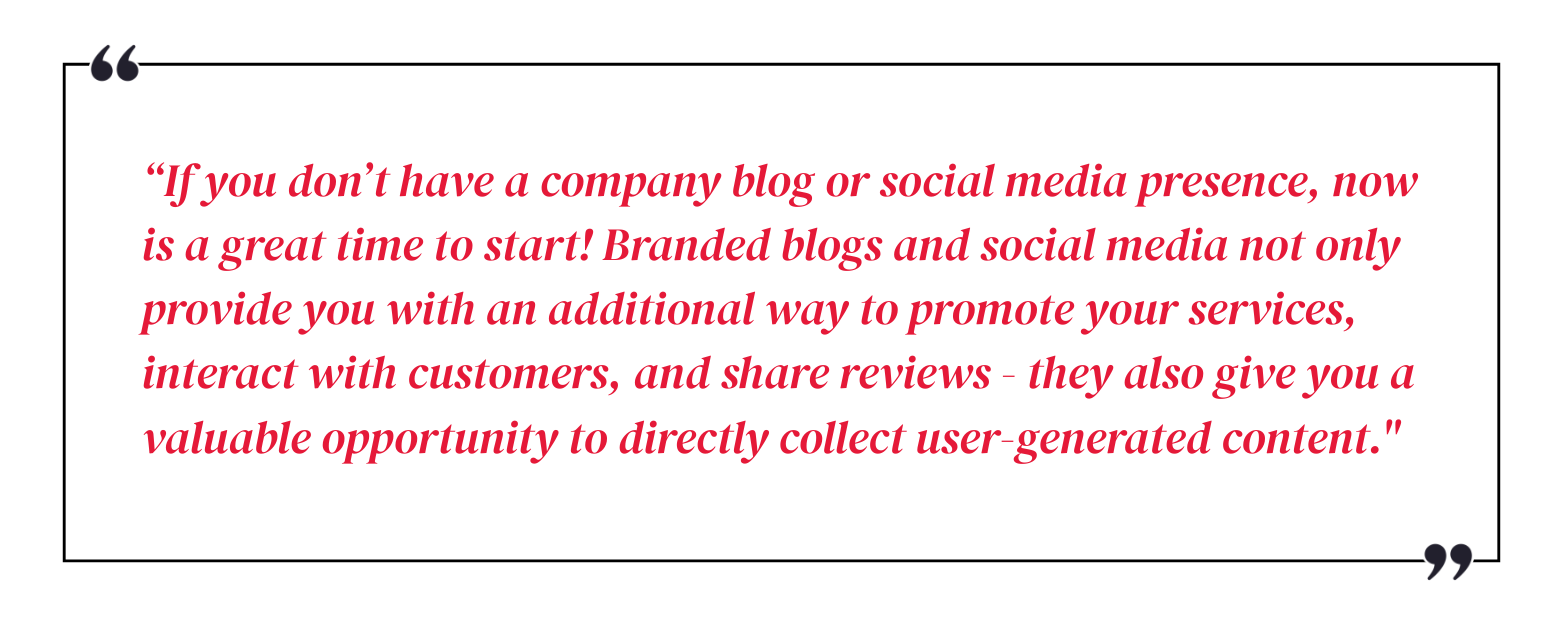Unlocking the Power of User-Generated Content

Your online presence is often the first impression potential clients have of your brand.
Authentic and engaging interactions with current and potential customers is more important now than ever. Keeping your content fresh, dynamic, and personal builds consumer trust. And one of the best ways to generate new content is by calling on one of your most valuable assets, your customers.
User-generated content (UGC) is the digital equivalent of old school word-of-mouth advertising. It’s any form of content – text, images, videos, reviews, etc. – created by your customers and clients about your brand, product, or services. When you think about businesses you trust the most, it’s likely that many of those were discovered through online reviews or social media. Businesses both large and small are using UGC, oftentimes over more traditional advertising methods, to build credibility and drive growth.
Leveraging your customers’ enthusiasm to attract and convert new customers can be incredibly powerful. But knowing exactly how to do this is key.
You don’t have to navigate this task alone! We will walk you through the process, from understanding the different types of UGC to implementing strategies for collection, moderation, and display on your website.
Why should you utilize user-generated content?
Before we jump into best practices for incorporating UGC into your website, let’s explore the benefits of utilizing content created by your users.
- Builds Trust and Credibility: We are mentioning this point first because it is truly the biggest reason to add UGC to your website! The reality is that consumers trust what others say about your company more than what you say about yourself. It’s just human nature to trust the experiences of real customers over a company’s own efforts to promote products and services. Customer experiences provide trustworthy proof that your company or service will do what you say it does.
- Increases Engagement: UGC encourages interaction and builds a sense of community around your brand. When users see their content featured, they feel valued. And this feeling means your customers and clients are more likely to be repeat patrons.
- Boosts Conversions: Seeing others use and benefit from your products or services can have a huge influence on purchasing decisions. UGC provides credibility which, in turn, creates customers.
- Provides Fresh, Diverse Content: Consistently generating high-quality content can be a challenge. UGC provides a continuous stream of diverse and relatable content that speaks to potential customers and clients in a powerful way.
- Improves SEO: Fresh and regularly updated content is favored by search engines and can improve your website’s ranking. Incorporating user-generated content into your marketing plan is one way to promote your brand’s presence on search engines.
- Offers Valuable Insights: Knowing what your customers and clients are saying about you online is like having a live action quality assurance team at your fingertips! user-generated content lets you know what people love about your brand – and what you might need to improve.
 What exactly is user-generated content?
What exactly is user-generated content?
There are many types of user-generated content, and what you choose to focus on depends on your business, your audience, and your goals.
- Customer Reviews and Testimonials: These are the most straightforward and, likely, the most powerful forms of UGC. Written reviews and video testimonials detailing positive experiences build immediate trust. This type of content is beneficial to pretty much every business out there!
- Social Media Posts: Photos and videos shared on platforms like Instagram, Facebook, YouTube X, and TikTok featuring your products or services are invaluable. Consider thinking of a brand specific hashtag for customers and clients to use. This can help you track and collect content posted about your brand on social media.
- Customer Photos and Videos: Users might also share photos and videos directly with you sharing how they use your products or service.
- Blog Comments and Forum Discussions: Online discussion about your brand or service can generate useful UGC as well. These can be from your own company’s blog, other online blogs, and community forums such as Reddit.
- Blog Posts, Articles, and Case Studies: Depending on your business type, you might find more lengthy content regarding your products or services. Oftentimes you will be made aware when content such as this is being posted about your brand, but you can do your own online research for these types of UGC through simple internet searches using your brand name or specific products you offer.
- Email, Phone Calls, and Private Social Media Interactions: It’s likely you are interacting with your customers regularly, whether it is via email, through a phone call, via social media direct messages, or even in person. Customers often contact you directly with questions or to provide feedback. These interactions, while not often considered when thinking of UGC, can also be a functional source of user-generated content.
Are you ready to harness the power of user-generated content?
If you don’t know where to start, there are some simple steps you can take to start building a strong user-generated content implementation plan.
Step 1: Define Your Goals and Create a Strategy
Before you start collecting content, think about why you want to utilize UGC and what you hope to accomplish.
- What are your objectives? Are you hoping to increase conversions on product pages, build brand recognition, or gather authentic marketing material?
- What types of UGC are most relevant to your business and audience? If you sell physical products, photos and videos could have the most impact. If you offer services, testimonials and written reviews could be more useful.
- Where on your website will you feature UGC? Consider adding positive reviews to product pages, creating a dedicated testimonials section or page, or even featuring blurbs and/or visual content from customers on your homepage. And don’t forget your own blog and social media! If you don’t have a company blog or social media presence, now is a great time to start! Branded blogs and social media not only provide you with an additional way to promote your services, interact with customers, and share reviews – they also give you a valuable opportunity to directly collect UGC. You can even add a social media feed to your website so visitors can immediately see customer/client interactions on other platforms.
Having a defined UGC integration strategy will help you stay focused on your goals!
Step 2: Plan Your Collection Methods
How will you encourage and collect UGC from your customers? The easier it is for your customers to provide user-generated content the easier it will be for you to collect it!
- Direct Calls to Action: Ask for reviews on product pages or after a purchase. This might seem obvious, but people often feel reluctant to directly ask for reviews. But think about this – when you believe in your products or services, you can (and should!) feel proud to ask for feedback! Happy customers are often happy to provide glowing reviews. Don’t forget to encourage your customers and clients to post reviews on social media with those hashtags we mentioned brainstorming about earlier (hint, hint!).
- Contests and Campaigns: Everyone loves a chance to win a prize or be recognized! Run social media contests or campaigns that encourage your customers to create and share content related to your brand. Get creative!
- Direct Outreach: Send follow-up emails (or make a quick call) to your customers or clients asking for feedback or inviting customers to share photos. We all know that personal interactions go a long way – but be genuine! A quick, personal email or phone call can make a lasting impression – which also means your patrons will be more likely to share positive reviews.
- Dedicated Submission Forms: Adding a simple form to your website where users can easily upload photos, videos, or written testimonials is a great way to passively collect UGC.
- Integration with Social Media Platforms: Consider using a plugin or tool that allows you to directly feed content from your social media platforms to your website using hashtags (there we go with the hashtags again!) or mentions.
Always make sure your calls to action are clear and genuine – you will likely see that your customers and clients are happy to share their experiences!

Step 3: Don’t Forget to Moderate
It probably won’t come as a surprise that not all user-generated content will be suitable for your website. Don’t overlook moderation when you utilize UGC.
- Establish Guidelines: Determine what kind of content is acceptable for your site and what is not. The content you use should align with your brand values and goals.
- Manual Moderation: For smaller volumes of UGC, manual review by a team member is typically the best method. This allows you to carefully vet and select what content those who visit your site see.
- Automated Moderation Tools: If manual moderation isn’t possible or reasonable, there are tools that employ AI to filter profanity, spam, and inappropriate content. Even when automated moderation is in place we do recommend doing periodic reviews if your UGC is being fed directly to your site – just to be safe!
- The Combination Approach: You can find a happy medium between manual and automated moderation by using a combination of automated filters for the first pass followed by a secondary manual review of AI approved content before it is published on your live site.
- Be Timely: Reviewing and approving/posting UGC in a timely manner encourages continued participation from your customers and clients.
Moderation protects your company’s reputation by ensuring only appropriate and relevant content makes its way onto your site.
Step 4: Ask for Permission
Just because someone posts about your brand publicly doesn’t mean they consent to you using their content on your website. Asking for permission (or having blanket usage rights) is a must!
- Direct Request: If you find compelling UGC on social media, reach out to the creator directly to ask for permission to feature it on your website. Be specific about where and how you plan to use it.
- Terms and Conditions: Clearly state that users grant you permission to use content they submit by including an intent to use disclaimer on forms or in contest rules. Including a click to agree button is a good way to confirm consent. It’s always good to detail how you plan to use submitted content, such as indicating it could be used on your website or in marketing materials.
- UGC Platforms with Rights Management: Many dedicated UGC platforms have built-in features for requesting and managing content rights.
Obtaining permission to use content is not only for your own protection – it also builds trust with those who post about your products or services.
Step 5: Integrate user-generated Content into Your Website Design
How you choose to display UGC on your website can be just as important as the content itself. It should be seamlessly integrated to enhance, not hinder, user experience. Web development professionals can be a valuable source of guidance regarding best practices for user-generated content implementation.
- Include UGC on Relevant Pages: Display product reviews on correlating product pages, testimonials on a dedicated testimonial section or page, and social media feeds on your homepage or blog.
- Don’t Forget Aesthetics: Use grids, carousels, or sliders to display sets of UGC. Single testimonials, reviews, images, and videos can be displayed in a dedication section or box that matches the theme of your website.
- Highlight Impactful Statements: For reviews and testimonials, you can choose to feature a key statement to have a stronger impact rather than using the entire review or testimonial. Did a client say you are one of the best companies they’ve ever worked with? Use that impact statement to your advantage!
- Make it Easy to Navigate: If you have a large volume of UGC, implement filtering or search options to help users find what they’re looking for. If a potential customer is looking for reviews about a specific product, they typically want to go straight to the information that is useful to them. Providing filtering and search capabilities will help them find exactly what they’re looking for without having to scroll through reviews that aren’t relevant to them.
- Ensure Mobile Responsiveness: Just like the rest of your website, user-generated content that you add to your site should be easy to navigate both desktop and mobile devices.
User-generated content should work for you, not against you. Thoughtfully considering how and where you add UGC content to your website will benefit both you and your website visitors.

Step 6: Let Everyone Know You Want Their Input!
Let your clients and customers know that you want to share their content!
- Promote Your Hashtag: Again with the hashtags! They are one of the simplest ways you can collect user-generated content on social media, so they deserve another mention! Mention your brand’s hashtag in a noticeable place on your website, social media profiles, and marketing materials so customers and clients remember it. And don’t forget to use it yourself! When you make posts on your company’s social media, always include your hashtag in the text.
- Include UGC Everywhere – Not Just Your Website: Share impactful user-generated content in email newsletters, on social media, and even in paid advertising (with permission, of course!).
- Highlight Featured Clients or Customers: Give a shout-out to your clients and customers whose content you feature on your website. Recognizing those who give you great user-generated content to use encourages others to do the same!
Actively encouraging your clients and customers to post and share thoughts about your products or services is the best way to have a constant flow of fresh content for your site!
Step 7: Review and Refine
The online social world is constantly evolving. New trends emerge and old trends disappear. What worked for you last month may not be the best approach this month which means you can’t just add user-generated content to your site and forget about it. Tracking how your content performs is vital but it’s also helpful to have a bit of knowledge about trends, both in your company’s field and in the online social media world in general. That doesn’t mean you have to become a social media expert! Just a little research about popular social media trends can go a long way. With your content performance and business/social trends in mind, you can refine your strategy as needed.
- Use Google Analytics: Set up and implement Google Analytics and get to know the platform. This will absolutely be one of your very best assets for tracking the performance of your website and social media platforms. Consider hiring an SEO professional to guide you through this process – they can be a valuable resource when navigating your online performance.
- Monitor Engagement Metrics: Engagement is one the most straightforward ways to gauge content performance. Keep up with the number of likes, comments, shares, and clicks on your website and your social media platforms. This will guide your strategy – if something performs well, keep it up! If you notice certain things aren’t getting the engagement you hoped they would, shift gears!
- Analyze Traffic and Conversion Rates: Do pages with user-generated content have higher conversion rates or lower bounce rates compared to those that don’t? This will help you identify whether your UGC strategy is working or if you need to make some adjustments.
- Gather Customer/Client Feedback: Ask your customers or clients what type of content they enjoy seeing and how they’d like to contribute, then use this information to refine your strategy.
Regularly analyzing what is working for your company and what isn’t will ensure the user-generated content you are utilizing is making a positive impact!
Engage Your Customers, Elevate Your Website
Authentic engagement is one of your most powerful marketing tools. Incorporating user-generated content into your website builds trust, increases engagement, and promotes growth in our dynamic online world. When you give happy customers a voice, they will encourage others to become customers as well. User-generated content can (and should) be a foundational part of your company’s success – but it doesn’t have to be overwhelming!
You can start small by focusing on collecting and displaying customer reviews then gradually increase your UGC efforts over time. This is not an all or nothing effort! Even a few reviews or client images can have a big impact. If you need help developing and implementing a user-generated content strategy, get in touch with a web development professional today!
Posted in: Austin Web Design, Content Marketing, E-learning, How To, Internet Marketing, Marketing, PR/Advertising, Social Media, Social Networking
Comments are closed.
Latest & Greatest
- How to Prepare Your Website Content
- How to Fix Common Website Bugs
- Security Enhancements for Website Checkout
- How To Write Content Geared Toward AI Search
- How to Recover a Broken Website
- Designing for Trust: How to Build Credibility in Your Website
- Why Humans Still Matter: The Irreplaceable Role of Human Insight in Web Design

